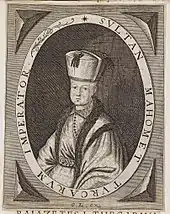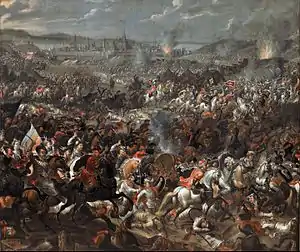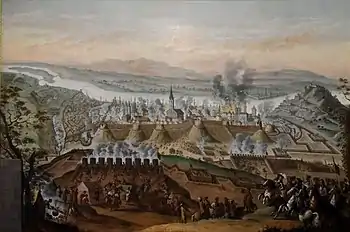Mehmed IV
Mehmed IV (Ottoman Turkish: محمد رابع, romanized: Meḥmed-i rābi; Turkish: IV. Mehmed; 2 January 1642 – 6 January 1693) also known as Mehmed the Hunter (Turkish: Avcı Mehmed) was the Sultan of the Ottoman Empire from 1648 to 1687. He came to the throne at the age of six after his father was overthrown in a coup. Mehmed went on to become the second longest reigning sultan in Ottoman history after Suleiman the Magnificent.[1] While the initial and final years of his reign were characterized by military defeat and political instability, during his middle years he oversaw the revival of the empire's fortunes associated with the Köprülü era. Mehmed IV was known by contemporaries as a particularly pious ruler, and was referred to as gazi, or "holy warrior" for his role in the many conquests carried out during his long reign.[2]
| Mehmed IV محمد رابع | |||||
|---|---|---|---|---|---|
| Kayser-i Rûm Amir al-Mu'minin Custodian of the Two Holy Mosques Ottoman Caliph | |||||
.jpg.webp) Portrait of Mehmed IV (oil on canvas, 1682) | |||||
| 19th Sultan of the Ottoman Empire (Padishah) | |||||
| Reign | 8 August 1648 – 8 November 1687 | ||||
| Predecessor | Ibrahim | ||||
| Successor | Suleiman II | ||||
| Regents | See list
| ||||
| Born | 2 January 1642 Topkapı Palace, Constantinople, Ottoman Empire (present day Istanbul, Turkey) | ||||
| Died | 6 January 1693 (aged 51) Edirne, Ottoman Empire (present day Edirne, Turkey) | ||||
| Burial | Tomb of Turhan Sultan, New Mosque, Istanbul, Turkey | ||||
| Consort | Gülnuş Sultan Afife Kadın | ||||
| Issue | see below | ||||
| |||||
| Dynasty | Ottoman | ||||
| Father | Ibrahim | ||||
| Mother | Turhan Sultan | ||||
| Religion | Sunni Islam | ||||
| Tughra |  | ||||
Under his reign the empire reached the height of its territorial expansion in Europe. From a young age he developed a keen interest in hunting, for which he is known as avcı (translated as "the Hunter").[1] In 1687 Mehmed was overthrown by soldiers disenchanted by the course of the ongoing War of the Holy League. He subsequently retired to Edirne, where he resided until his natural death in 1693.[1]
Early life

Born at Topkapı Palace, Constantinople, in 1642, Mehmed was the son of Sultan Ibrahim (r. 1640–48) by Turhan Sultan, a concubine of Russian origin,[3][4] and the grandson of Kösem Sultan of Greek origin.[5] Soon after his birth, his father and mother quarreled, and Ibrahim was so enraged that he tore Mehmed from his mother's arms and flung the infant into a cistern. Mehmed was rescued by the harem servants. However, this left Mehmed with a lifelong scar on his head.[6]
Reign
Accession
Mehmed ascended to the throne in 1648 at the age of six,[nb 1] during a very volatile time for the Ottoman dynasty. On 21 October 1649, Mehmed along with his brothers Suleiman and Ahmed were circumcised. [8] The empire faced palace intrigues as well as uprisings in Anatolia, the defeat of the Ottoman navy by the Venetians outside the Dardanelles, and food shortages leading to riots in Constantinople. It was under these circumstances that Mehmed's mother granted Köprülü Mehmed Pasha full executive powers as Grand Vizier. Köprülü took office on 14 September 1656.[9] Mehmed IV presided over the Köprülü era, an exceptionally stable period of Ottoman history. Mehmed is known as Avcı, "the Hunter", as this outdoor exercise took up much of his time.
Wars


Mehmed's reign is notable for a revival of Ottoman fortunes led by the Grand Vizier Köprülü Mehmed and his son Fazıl Ahmed. They regained the Aegean islands from Venice, and Crete, during the Cretan War (1645–1669). They also fought successful campaigns against Transylvania (1660) and Poland (1670–1674). When Mehmed IV accepted the vassalage of Petro Doroshenko, Ottoman rule extended into Podolia and Right-bank Ukraine. His next vizier, Köprülü Mehmed's adopted son Merzifonlu Kara Mustafa, led campaigns against Russia, conquering Chyhyryn in 1678. He next supported the 1683 Hungarian uprising of Imre Thököly against Austrian rule, marching a vast army through Hungary and besieged Vienna. At the Battle of Vienna on the Kahlenberg Heights, the Ottomans suffered a catastrophic rout by Polish-Lithuanian forces famously led by King John III Sobieski (1674–96), and his allies, notably the Imperial army.
In 1672 and 1673, the sultan, who embarked on two Polish campaigns with serdar-ı ekrem and Grand Vizier Fazıl Ahmed Pasha, and the acquisition of the Kamaniçi Castle, returned to Edirne after the signing of the Bucaş Treaty. [10]
Fire of 1660
The fire of 4–5 July 1660 was the worse conflagration the Ottoman city had experienced to that date. It started in Eminönü and spread to most of the historic peninsula, burning much of the city. Even the minarets of Suleiman I's mosque burned. Two-thirds of Istanbul was turned to ash in the conflagration, as many as forty thousand people were killed. Thousands died in the famine and plague which followed the fire. Following the fire, the dynasty expelled Jews from a wide swath of Istanbul, confiscated their synagogues and homes so that in their place the Yeni Cami (New Mosque) and the Spice Bazaar (Egyptian Market) could be built.[11]
Great Turkish War

On 12 September 1683 the Austrians and their Polish allies under King John III Sobieski won the Battle of Vienna with a devastating flank attack led by Sobieski's Polish cavalry. The Turks retreated into Hungary, however this was only the beginning of the Great Turkish War, as the armies of the Holy League began their successful campaign to push the Ottomans back to the Balkans.
Later life and death


In May 1675 his sons Mustafa II and Ahmed III were circumcised and his daughter Hatice Sultan was married. The empire celebrated it with Famous Edirne Festival to mark the occasion. [10] Silahdar Findikli Mehmed Aga, He described Mehmed as a medium-sized, stocky, white-skinned, sun-burnt face, sparse beard, leaning forward from the waist up because he rides a lot. [12]
1680 witnessed the only known stoning to death of a woman convicted for adultery in Ottoman Istanbul. The unnamed woman was stoned to death on Istanbul's Hippodrome after allegedly being caught alone with a Jewish man, violating Ottoman law which forbade sexual relations between Christian or Jewish men and Muslim women. Mehmed IV witnessed the double execution: he offered the man conversion to Islam so as to avoid being stoned to death (he was beheaded instead).[13]
After the second Battle of Mohács (1687), the Ottoman Empire fell into deep crisis. There was a mutiny among the Ottoman troops. The commander and Grand Vizier, Sarı Süleyman Pasha, became frightened that he would be killed by his own troops and fled from his command, first to Belgrade and then to Istanbul. When the news of the defeat and the mutiny arrived in Istanbul in early September, Abaza Siyavuş Pasha was appointed as the commander and soon afterward as the Grand Vizier. However, before he could take over his command, the whole Ottoman Army had disintegrated and the Ottoman household troops (Janissaries and sipahis) started to return to their base in Istanbul under their own lower-rank officers. Sarı Süleyman Pasha was executed, and Sultan Mehmed IV appointed the commander of Istanbul Straits, Köprülü Fazıl Mustafa Pasha, as the Grand Vizier's regent in Istanbul. Fazıl Mustafa made consultations with the leaders of the army that existed and the other leading Ottoman statesmen.
After these, on 8 November 1687 it was decided to depose Sultan Mehmed IV and to enthrone his brother Suleiman II as the new Sultan. Mehmed was deposed by the combined forces of Yeğen Osman and the Janissaries. Mehmed was then imprisoned in Topkapı Palace. However, he was permitted to leave the Palace from time to time, as he died in Edirne Palace in 1693. He was buried in Turhan Sultan's tomb, near his mother's mosque in Constantinople. In 1691, a couple of years before his death, a plot was discovered in which the senior clerics of the empire planned to reinstate Mehmed on the throne in response to the ill health and imminent death of his successor, Suleiman II.
His favourite harem girl was Gülnuş Sultan, a slave girl and later his wife. She was taken prisoner at Rethymno (Turkish Resmo) on the island of Crete. Their two sons, Mustafa II and Ahmed III, became Ottoman Sultans during 1695–1703 and 1703–1730 respectively.
Family
- Consorts
Mehmed had two consorts:
- Gülnuş Sultan;
- Afife Kadın;[14]
- Sons
- Mustafa II (6 February 1664 – 30 December 1703) – son with Gülnuş Sultan;
- Ahmed III (30 December 1673 – 1 July 1736) – son with Gülnuş Sultan;
- Şehzade Bayezid (15 December 1678 – 18 December 1678, buried in Sultan Mustafa I Mausoleum, Hagia Sophia);[14]
- Daughters
- Hatice Sultan (1668[14] – Edirne, 5 July 1743, buried in New Mosque, Istanbul),[15] daughter with Gülnuş Sultan,[16] married firstly on 9 July 1675 to Musahip Mustafa Pasha, married secondly on 13 March 1691 to Moralı Hasan Pasha;[17][14]
- Fatma Sultan (1672 – Eyüp Palace, 5 December 1700, buried in New Mosque, Istanbul), daughter with Gülnuş Sultan,[16] married firstly on 9 July 1675 to Kara Mustafa Pasha, married secondly on 19 January 1696 to Tırnakçı Çerkes Ibrahim Pasha, married thirdly to Vezir Mısırlı Mehmed Pasha;[18][19]
- Ümmi Sultan (died of smallpox, 21 December 1700, buried in New Mosque, Istanbul), married on 13 January 1694 in the Edirne Palace to Silahdar Çerkes Osman Pasha;[20][19]
See also
Notes
- He is often reported as having been seven years old upon his accession, a result of the Turkish method of calculating age.[7]
References
- Börekçi, Günhan (2009). "Mehmed IV". In Ágoston, Gábor; Bruce Masters (eds.). Encyclopedia of the Ottoman Empire. pp. 370–1.
- Baer, Marc David (2008). Honored by the Glory of Islam: Conversion and Conquest in Ottoman Europe. Oxford University Press. p. 165. ISBN 978-0-19-979783-7.
- Afyoncu; Uğur Demir, Erhan (2015). Turhan Sultan. Istanbul: Yeditepe Yayınevi. p. 27. ISBN 978-605-9787-24-6.
- Baer, Marc David (2008). Honored by the Glory of Islam: Conversion and Conquest in Ottoman Europe. Oxford University Press. p. 35. ISBN 978-0-19-979783-7.
- Finkel, Caroline (2005). Osman's Dream: The Story of the Ottoman Empire, 1300-1923. New York: Basic Books. p. 197. ISBN 978-0-465-02396-7.
- John Freely - Inside the Seraglio published 1999, Chapter 9: Three Mad Sultans
- Baer, Marc David (2008). Honored by the Glory of Islam: Conversion and Conquest in Ottoman Europe. Oxford University Press. p. 27. ISBN 978-0-19-979783-7.
- Sakaoğlu 2015, p. 271.
- Streusand, Donald E., Islamic Gunpowder Empires: Ottomans, Safavids, and Mughals (Boulder, Colo.: Westview Press, 2011), p. 57.
- Sakaoğlu 2015, p. 266.
- Marc David Baer, “The Great Fire of 1660 and the Islamization of Christian and Jewish Space in Istanbul.” International Journal of Middle East Studies 36, no. 2 (May 2004): 159-181.
- Sakaoğlu 2015, p. 270.
- Marc David Baer, "Death in the Hippodrome: Sexual Politics and Legal Culture in the Reign of Mehmet IV." Past & Present 210, no. 1 (February 2011): 61-91.
- Silahdar Findiklili Mehmed Agha (2012). ZEYL-İ FEZLEKE (1065-22 Ca.1106 / 1654-7 Şubat 1695). pp. 530, 752–53, 1095, 1290.
- Sakaoğlu 2008, p. 380.
- Majer, Hans Georg (1992). The Journal of Ottoman Studies XII: The Harem of Mustafa II (1695-1703). p. 441.
- Uluçay 2011, p. 109.
- Uluçay 2011, p. 110.
- Silahdar Findiklili Mehmed Agha (2001). Nusretnâme: Tahlil ve Metin (1106-1133/1695-1721). pp. 135, 458–9, 841.
- Uluçay 2011, p. 111.
Bibliography
- Marc David Baer, “The Great Fire of 1660 and the Islamization of Christian and Jewish Space in Istanbul.”
International Journal of Middle East Studies 36, no. 2 (May 2004): 159-181.
- Marc David Baer, Honored by the Glory of Islam: Conversion and Conquest in Ottoman Europe (New York: Oxford University Press, 2008)
- Marc David Baer, "Death in the Hippodrome: Sexual Politics and Legal Culture in the Reign of Mehmet IV." Past & Present 210, no. 1 (February 2011): 61-91.
- Sakaoğlu, Necdet (2015). Bu Mülkün Sultanları. Alfa Yayıncılık. ISBN 978-6-051-71080-8.
- Sakaoğlu, Necdet (2008). Bu mülkün kadın sultanları: Vâlide sultanlar, hâtunlar, hasekiler, kadınefendiler, sultanefendiler. Oğlak Yayıncılık.
- Uluçay, Mustafa Çağatay (2011). Padişahların kadınları ve kızları. Ankara, Ötüken.
External links
![]() Media related to Mehmed IV at Wikimedia Commons
Media related to Mehmed IV at Wikimedia Commons
Mehmed IV Born: 2 January 1642 Died: 6 January 1693[aged 51] | ||
| Regnal titles | ||
|---|---|---|
| Preceded by Ibrahim |
Sultan of the Ottoman Empire 8 August 1648 – 8 November 1687 with Kösem Sultan (1648–1651) Turhan Hatice Sultan (1651–1656) |
Succeeded by Suleiman II |
| Sunni Islam titles | ||
| Preceded by Ibrahim |
Caliph of the Ottoman Caliphate 8 August 1648 – 8 November 1687 |
Succeeded by Suleiman II |
.svg.png.webp)